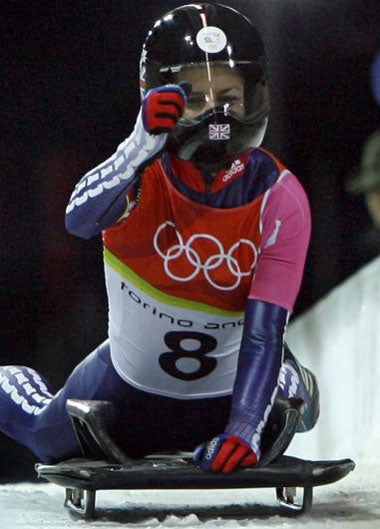At 85mph, on a tray, face inches from the ice, novice races to Britain's first Olympic medal

Shortly after 6pm yesterday, that £400 investment paid off with an Olympic silver medal in the skeleton bobsleigh, an event requiring competitors to travel at 70mph down an ice-lined tube, head-first and face down, separated from serious injury by what is to all intents and purposes a tea tray.
To the delirious delight of supporters in the Moonrakers, the pub in the Wiltshire village of Pewsey that is her home, the 24-year-old teaching assistant became an improbable national hero by hurtling down the track in Italy in 2 minutes 1.49 seconds over two runs of the 1,435m track.
Rudman, Britain's first medal winner of the Turin Games, was dislodged from the gold medal position only during the last run of the event, by the European champion, Maya Pederson from Switzerland.
Rudman bought her first sled a little over three years ago and relied on funds raised by family and regulars at the Moonrakers to compete around the world.
The former sports studies student, turned down for National Lottery sports funding, said yesterday: "This is beyond my wildest dreams. I hope they'll be dancing in the Moonrakers tonight."
Amid the chinking of glasses, residents who had packed into the pub to watch the event, declared their satisfaction that the £10,000 raised by the Shelley Rudman Supporters Group, including the £4,000 proceeds from a recent sponsored canoe paddle, was money well spent.
Gerry Cunkler, the landlord, said: "She did our village and Great Britain proud. There's footballers out there who earn £80,000 a week and they chop around on the grass and they think they earned their money.
"But Shelley slid down that track like a hero and won us our first medal through her nerve, her reactions and her guts."
Colin Harris, 65, a retired policeman who led the fundraising, said: " Any little bit we might have done is fantastic but she got on that podium with her own courage and ability." Rudman had not even been near a bob skeleton when she watched the last Winter Olympics at Salt Lake City in 2002 and saw another Wiltshire athlete, Alex Coomber, win the skeleton bronze. Within months, she met Coomber at the opening of a £300,000 winter sports "push-start" ice-run at Bath University, the closest thing Britain has to a bobsleigh track.
But not until she paid £400 for a holiday in Lillehammer, Norway, in October 2002 and tried the skeleton was her appetite whetted. Despite finding her first run "very, very scary", she began her ascent up the international rankings. But while Coomber was expected to get a medal in 2002, Rudman arrived at these Games as no more than a likely contender. Her biggest medal chance was calculated by British team chiefs to be in Vancouver in 2010. But victory in the last of the pre-event practices raised headier possibilities.
She said: "I was going for the top six and if everything went right on the day, then maybe bronze."
Britain's achievement in winning three medals at the last Winter Olympics (although one was taken away after the doping infraction of skier Alain Baxter) was something of a blip.
One medal is par for the course, but most observers reckoned it would be provided here by either the men or women's curling teams.
The skeleton
* Skeleton is the oldest sledding sport
* It was invented in St Moritz for the Cresta Run
* Despite first being included in 1928, it only became a permanent Olympic event in 2002
* It takes its name from competitors stripping sleds down to their bare frames
* Skeleton sliders reach speeds of 85mph
* Skeleton is slightly slower than the luge event
* The sled is pushed or "thrust" for the first 45m and then ridden - head first - downhill
* The athlete steers by transferring weight from left to right of the body
* Sliders wear a helmet, a visor and an aerodynamic suit
* The metal sled measures between 80 and 120cm, and weighs a maximum of 33kg
* The Olympic course is called the Cesana Pariol
* It is 1,430m long with a hairpin and an S-bend and has a vertical drop of 114m
Subscribe to Independent Premium to bookmark this article
Want to bookmark your favourite articles and stories to read or reference later? Start your Independent Premium subscription today.

Join our commenting forum
Join thought-provoking conversations, follow other Independent readers and see their replies